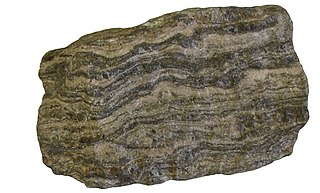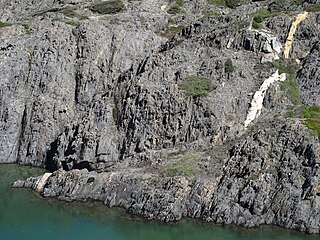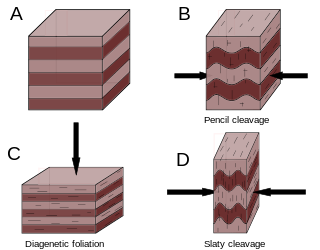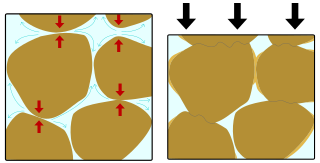
Gneiss is a common and widely distributed type of metamorphic rock. It is formed by high-temperature and high-pressure metamorphic processes acting on formations composed of igneous or sedimentary rocks. This rock is formed under pressures anywhere from 2 to 15 kbar, sometimes even more, and temperatures over 300 °C (572 °F). Gneiss nearly always shows a banded texture characterized by alternating darker and lighter colored bands and without a distinct cleavage.

Structural geology is the study of the three-dimensional distribution of rock units with respect to their deformational histories. The primary goal of structural geology is to use measurements of present-day rock geometries to uncover information about the history of deformation (strain) in the rocks, and ultimately, to understand the stress field that resulted in the observed strain and geometries. This understanding of the dynamics of the stress field can be linked to important events in the geologic past; a common goal is to understand the structural evolution of a particular area with respect to regionally widespread patterns of rock deformation due to plate tectonics.

Metamorphism is the transformation of existing rock to rock with a different mineral composition or texture. Metamorphism takes place at temperatures in excess of 150 °C (300 °F), and often also at elevated pressure or in the presence of chemically active fluids, but the rock remains mostly solid during the transformation. Metamorphism is distinct from weathering or diagenesis, which are changes that take place at or just beneath Earth's surface.

In geology, a shear zone is a thin zone within the Earth's crust or upper mantle that has been strongly deformed, due to the walls of rock on either side of the zone slipping past each other. In the upper crust, where rock is brittle, the shear zone takes the form of a fracture called a fault. In the lower crust and mantle, the extreme conditions of pressure and temperature make the rock ductile. That is, the rock is capable of slowly deforming without fracture, like hot metal being worked by a blacksmith. Here the shear zone is a wider zone, in which the ductile rock has slowly flowed to accommodate the relative motion of the rock walls on either side.

Mylonite is a fine-grained, compact metamorphic rock produced by dynamic recrystallization of the constituent minerals resulting in a reduction of the grain size of the rock. Mylonites can have many different mineralogical compositions; it is a classification based on the textural appearance of the rock.

In geology, shear is the response of a rock to deformation usually by compressive stress and forms particular textures. Shear can be homogeneous or non-homogeneous, and may be pure shear or simple shear. Study of geological shear is related to the study of structural geology, rock microstructure or rock texture and fault mechanics.

A porphyroblast is a large mineral crystal in a metamorphic rock which has grown within the finer grained matrix. Porphyroblasts are commonly euhedral crystals, but can also be partly to completely irregular in shape.

Foliation in geology refers to repetitive layering in metamorphic rocks. Each layer can be as thin as a sheet of paper, or over a meter in thickness. The word comes from the Latin folium, meaning "leaf", and refers to the sheet-like planar structure. It is caused by shearing forces, or differential pressure. The layers form parallel to the direction of the shear, or perpendicular to the direction of higher pressure. Nonfoliated metamorphic rocks are typically formed in the absence of significant differential pressure or shear. Foliation is common in rocks affected by the regional metamorphic compression typical of areas of mountain belt formation.
Lineations in structural geology are linear structural features within rocks. There are several types of lineations, intersection lineations, crenulation lineations, mineral lineations and stretching lineations being the most common. Lineation field measurements are recorded as map lines with a plunge angle and azimuth.

In geology, texture or rock microstructure refers to the relationship between the materials of which a rock is composed. The broadest textural classes are crystalline, fragmental, aphanitic, and glassy. The geometric aspects and relations amongst the component particles or crystals are referred to as the crystallographic texture or preferred orientation. Textures can be quantified in many ways. A common parameter is the crystal size distribution. This creates the physical appearance or character of a rock, such as grain size, shape, arrangement, and other properties, at both the visible and microscopic scale.

A porphyroclast is a clast or mineral fragment in a metamorphic rock, surrounded by a groundmass of finer grained crystals. Porphyroclasts are fragments of the original rock before dynamic recrystallisation or cataclasis produced the groundmass. This means they are older than the groundmass. They were stronger pieces of the original rock, that could not as easily deform and were therefore not or hardly affected by recrystallisation. They may have been phenocrysts or porphyroblasts in the original rock.

Stylolites are serrated surfaces within a rock mass at which mineral material has been removed by pressure dissolution, in a deformation process that decreases the total volume of rock. Minerals which are insoluble in water, such as clays, pyrite and oxides, as well as insoluble organic matter, remain within the stylolites and make them visible. Sometimes host rocks contain no insoluble minerals, in which case stylolites can be recognized by change in texture of the rock. They occur most commonly in homogeneous rocks, carbonates, cherts, sandstones, but they can be found in certain igneous rocks and ice. Their size vary from microscopic contacts between two grains (microstylolites) to large structures up to 20 m in length and up to 10 m in amplitude in ice. Stylolites usually form parallel to bedding, because of overburden pressure, but they can be oblique or even perpendicular to bedding, as a result of tectonic activity.

Cleavage, in structural geology and petrology, describes a type of planar rock feature that develops as a result of deformation and metamorphism. The degree of deformation and metamorphism along with rock type determines the kind of cleavage feature that develops. Generally, these structures are formed in fine grained rocks composed of minerals affected by pressure solution.

In structural geology and diagenesis, pressure solution or pressure dissolution is a deformation mechanism that involves the dissolution of minerals at grain-to-grain contacts into an aqueous pore fluid in areas of relatively high stress and either deposition in regions of relatively low stress within the same rock or their complete removal from the rock within the fluid. It is an example of diffusive mass transfer.
In geology and materials science, a deformation mechanism is a process occurring at a microscopic scale that is responsible for deformation: changes in a material's internal structure, shape and volume. The process involves planar discontinuity and/or displacement of atoms from their original position within a crystal lattice structure. These small changes are preserved in various microstructures of materials such as rocks, metals and plastics, and can be studied in depth using optical or digital microscopy.

In geology, a rock's fabric describes the spatial and geometric configuration of all the elements that make it up. In sedimentary rocks, the fabric developed depends on the depositional environment and can provide information on current directions at the time of deposition. In structural geology, fabrics may provide information on both the orientation and magnitude of the strains that have affected a particular piece of deformed rock.
The Thiviers-Payzac Unit is a metasedimentary succession of late Neoproterozoic and Cambrian age outcropping in the southern Limousin in France. The unit geologically forms part of the Variscan basement of the northwestern Massif Central.
In geology oblique foliation, steady state foliation or oblique fabric is a special type of a tectonically produced foliation or fabric, most commonly in quartz-rich layers. The microtectonic structure can be used to determine the shear sense in shear zones and their associated rocks, usually mylonites.

Quartz is the most abundant single mineral in the Earth's crust, and as such is present in a very large proportion of rocks both as primary crystals and as detrital grains in sedimentary and metamorphic rocks. Dynamic recrystallization is a process of crystal regrowth under conditions of stress and elevated temperature, commonly applied in the fields of metallurgy and materials science. Dynamic quartz recrystallization happens in a relatively predictable way with relation to temperature, and given its abundance quartz recrystallization can be used to easily determine relative temperature profiles, for example in orogenic belts or near intrusions.
In structural geology, strain partitioning is the distribution of the total strain experienced on a rock, area, or region, in terms of different strain intensity and strain type. This process is observed on a range of scales spanning from the grain – crystal scale to the plate – lithospheric scale, and occurs in both the brittle and plastic deformation regimes. The manner and intensity by which strain is distributed are controlled by a number of factors listed below.













